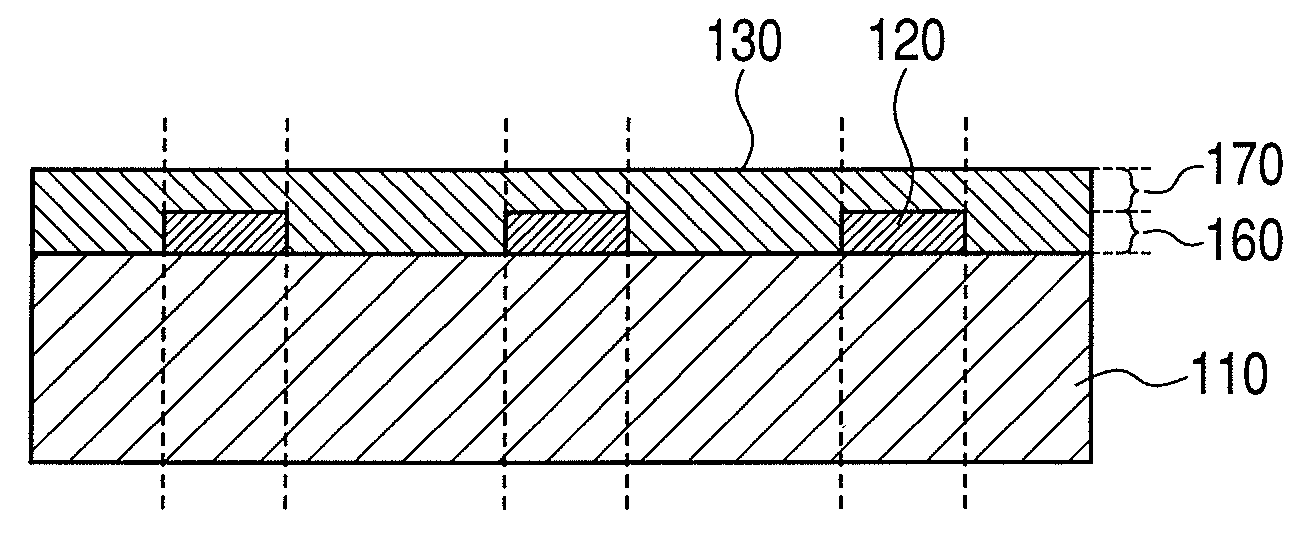Optical filter
a filter and optical technology, applied in the field of optical filters, can solve the problems of low energy efficiency of a device using a hole-type filter and large amount of light absorption, and achieve the effect of large surface area and greater degree of freedom
- Summary
- Abstract
- Description
- Claims
- Application Information
AI Technical Summary
Benefits of technology
Problems solved by technology
Method used
Image
Examples
first embodiment
Single-Layer Optical Filter and Laminated Optical Filter
[0128]Hereunder, an embodiment of the present invention is described using the drawings. First, the items denoted by reference numerals in the FIGS. are listed: 110: dielectric substrate, 120: metal structure, 121: first metal structure, 122: first metal structure, 130: dielectric layer, 140: first direction, 141: first length, 145: period, 150: second direction, 151: second length, 155: period, 160: thickness of metal structure, 170: thickness after subtracting metal structure thickness from dielectric layer thickness, 201: transmission spectrum R, 202: transmission spectrum G, 203: transmission spectrum B, 301: region, 302: region, 303: region, 401: first metal structure, 402: first metal structure group, 403: first metal structure, 404: first metal structure group, 405: period, 406: period, 407: first metal structure, 408: second metal structure, 501: first metal structure group, 502: first direction, 503: second direction, ...
second embodiment
Bayer Array
[0204]According to the present embodiment, an RGB filter arranged in a Bayer array is described.
[0205]In FIG. 3, for example, the aforementioned optical filter R (transmission spectrum 201) is arranged in a region 301, the optical filter G (transmission spectrum 202) is arranged in a region 302, and the optical filter B (transmission spectrum 203) is arranged in a region 303. By arranging the optical filters in this manner, it is possible to construct a color filter that is arranged in a Bayer array using the filters according to the present invention.
[0206]The above color filter can be used as a color filter for image capturing device. Region 301 etc. of the color filter has an area corresponding to one pixel, which may be greater than an area covered by the photoelectric conversion device (photoelectric conversion part).
[0207]According to the present embodiment, the sizes of the metal structures and the periods at which the metal structures are arranged differ for each ...
third embodiment
Triangular Lattice
[0212]FIG. 16 is a view that illustrates an embodiment in which metal structures are arranged in a triangular lattice shape. In the case of a triangular lattice arrangement, since the unit vector components of the lattice are not orthogonal, it is possible to reduce the dependence with respect to incident light polarization of the optical characteristics of the filter in comparison to a tetragonal lattice shape arrangement.
[0213]This kind of triangular lattice arrangement can also be expressed as a plurality of metal structure group arranged in a tetragonal lattice shape being disposed in overlapping regions.
[0214]More specifically, it is possible to express this arrangement in terms of a first metal structure group 1602 including first metal structures 1601 and a second metal structure group 1604 including second metal structures 1603 being arranged in overlapping regions.
PUM
| Property | Measurement | Unit |
|---|---|---|
| thickness | aaaaa | aaaaa |
| thickness | aaaaa | aaaaa |
| thickness | aaaaa | aaaaa |
Abstract
Description
Claims
Application Information
 Login to View More
Login to View More - R&D
- Intellectual Property
- Life Sciences
- Materials
- Tech Scout
- Unparalleled Data Quality
- Higher Quality Content
- 60% Fewer Hallucinations
Browse by: Latest US Patents, China's latest patents, Technical Efficacy Thesaurus, Application Domain, Technology Topic, Popular Technical Reports.
© 2025 PatSnap. All rights reserved.Legal|Privacy policy|Modern Slavery Act Transparency Statement|Sitemap|About US| Contact US: help@patsnap.com



